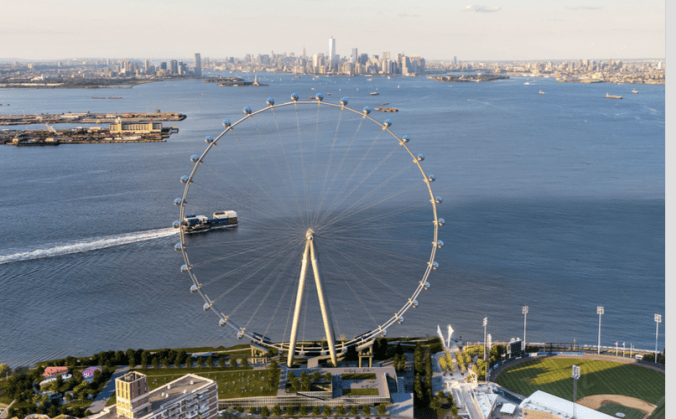
[courtesy of ]S9 Architecture / Perkins Eastman]
There, I feel better now. You might be wondering what caused that outburst. For once, it wasn’t the current occupant of the White House, who shall not be named. It has something to do with the rendering above. It’s the New York Wheel, and it is the great hope of Staten Island real estate developers.
Here’s the deal: Whenever money was pumped into St. George, bad things have followed. Can you say recession? The last big push was in the mid 2000s, and then 2008’s crash happened. That wasn’t the first time we’ve seen this happen. It’s almost as predictable as the tides.
And so, the latest St. George push. This gigantic Ferris wheel would lure all those tourists off the Staten Island Ferry—the best sightseeing bargain in the city—for a $30 ride. Then they’d see all the wonderful stores in the adjacent outlet shopping mall. Who can resist a Nordstrom Rack? And then knock back with a burger and beer at yet another Shake Shack? It’ll all be there at Empire Outlets.
The construction has turned the area around the Staten Island Ferry terminal into a traffic and construction nightmare. But we’re told it’s all for a good cause. St. George will be the new hot neighborhood—watch out, Williamsburg. We’re looking at you, Bushwick and Astoria! I don’t know about you, Staten Island friends, but I go to Zillow every few days and watch my house’s estimated value grow and grow. I don’t live in St. George, but I’m in the same zip code, and we’re already feeling the love.
 Our excitable local politicians aren’t the only ones wondering if this means a Staten Island renaissance is finally at hand. Press coverage has been consistently breathless, which goes to show that in New York City, it’s all about real estate. We’re obsessed, and our supposedly objective press organs are the official cheerleaders.
Our excitable local politicians aren’t the only ones wondering if this means a Staten Island renaissance is finally at hand. Press coverage has been consistently breathless, which goes to show that in New York City, it’s all about real estate. We’re obsessed, and our supposedly objective press organs are the official cheerleaders.
But why the panic? My cynical friends and I have been, shall we say, less than sanguine about the whole enterprise’s prospects. Sure, there might be decent views from the wheel, but seriously? The tourists are going to spend a few hours on a big ride and then in a shopping mall when they easily go back to lower Manhattan and annoy the workers trying to get somewhere? Will they forego the pleasures of shopping in the madhouse that is Century 21 for an outlet mall? Won’t this cut into their Wall Street bull posing time?
Okay, so let’s say the tourist turnout isn’t what its backers are projecting. There’s the rest of Staten Island looking for an exciting shopping experience, right? Well, no. See, this complex is on the North Shore. It’s not on the South Shore. This is very significant. There is a highway that runs across the island, about a third down the island from the northernmost point. It connects the Verrazano and Goethals Bridges, to Brooklyn and New Jersey, respectively. It also serves as a sort of Mason-Dixon line. North of the expressway, Staten Island sort of resembles the rest of the city. It’s more urban, diverse, and politically liberal. Most of the borough’s cultural institutions are there, and you know what sort of people work there.
South of the highway is, well, SopranoLand. It’s highly Italian-American, but of a certain kind. Many of these people left their homes in Brooklyn when, back in the 1960s and ’70s, the racial composition changed. Whether their fears of increased crime, etc., were real or not, they left their homes for what they hoped was safe—and where people were like them. There are lots of cops, firefighters, sanitation workers, and trade people. Unsurprisingly, they vote Republican and have sent conservatives to Congress and to the City Council. I doubt whether they’ll drive (basically the only way to get there) to the wheel and the mall there unless a gun is pointed at their heads. Trust me.
So forgive me my doubts about this great project. I’m not alone. As I write, the wheel itself is mired in litigation, with its owners and the contractors who are building it pointing fingers at each other and tossing accusations back and forth in court papers. It ain’t pretty, and it could doom the project itself.
Remember, you read it here first.



